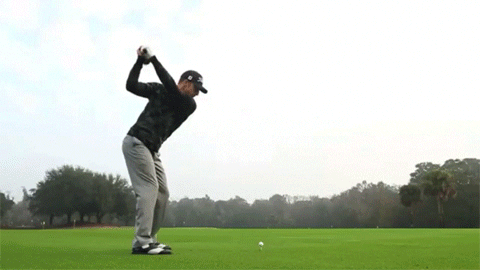The Loop
Peter Uihlein, "the modern-day prototype for the post-Tiger Woods era"
Lifting your back foot into the air used to be -- and in most cases, still is -- one of the first things an instructor will teach someone playing golf. For a little less stability, the theory goes, a right-handed golfer lifting his right foot helps him drive onto his left side and use the exaggerated weight transfer to hit ball further. If you weren't doing it, better to address it early -- unless you were happy hitting it nowhere. Enter Peter Uihlein and his former Oklahoma State teammate Morgan Hoffmann. Aside from their success on the golf course (the pair made more than $2 million combined in 2013, Uihlein playing the European Tour, Hoffmann the PGA Tour), it's the way they're achieving their success that may be most noteworthy. In a move that by conventional standards might have been considered quirky, Uihlein and Hoffman both keep their right foot planted on the ground throughout their swing, almost until its conclusion -- and they're not the only ones. Patrick Reed, one of the few rookies to win on the PGA Tour in 2013, is another, while golf historians will point out that this move was present in Moe Norman's swing, still considered by many the game's best ever ball striker.

Related: Sean Foley on how to smash your irons Morgan Hoffmann's instructor, Gary Gilchrist, agrees a stable lower body has become a key ingredient to Hoffmann's success. "Morgan keeping his feet on the ground is a million times better than lifting them up," Gilchrist, who ranked 32nd on our list, said. "As fast and as hard as he swings, he needs to give himself something solid to unwind on." Equipment is another important factor in this new phenomenon. Unlike any other generation of golfers in history, Uihlein and Hoffmann's generation have learned the game with equipment specifically designed to be easy to hit regardless of skill level.
"What's interesting is that the younger generation of players, like Pete and Morgan, are the first to grow up never needing to try to get the ball in the air," Harmon said. "Golf balls and golf clubs used to be really heavy and tough to hit...golfers needed to work really hard to get the ball off the ground."
In many ways, Harmon said, a player like Uihlein is "the modern-day prototype for the post-Tiger Woods era."
The result is a growing crop of golfers who have been given permission to swing harder, and harder, and harder, with their athleticism and equipment absolving them of most possible consequences. They can power it more than 300 yards with a lower body action designed for precision. In other words: they are having their cake, and eating it too.
So is this a new trend in golf? Not yet. Or at least not intentionally. A move like this requires both a tremendous amount of flexibility and strength, and demands the golf swing to be fundamentally sound in other ways -- all things that exclude most average golfers. But with an increasing number of athletes marching on to the PGA Tour, that back foot as a power source could become less and less important. "With the equipment these young guys are using, these guys are putting so much pressure into the ground and swinging so hard," Gilchrist said. "We've got a whole new generation of golfers who just attack everything."